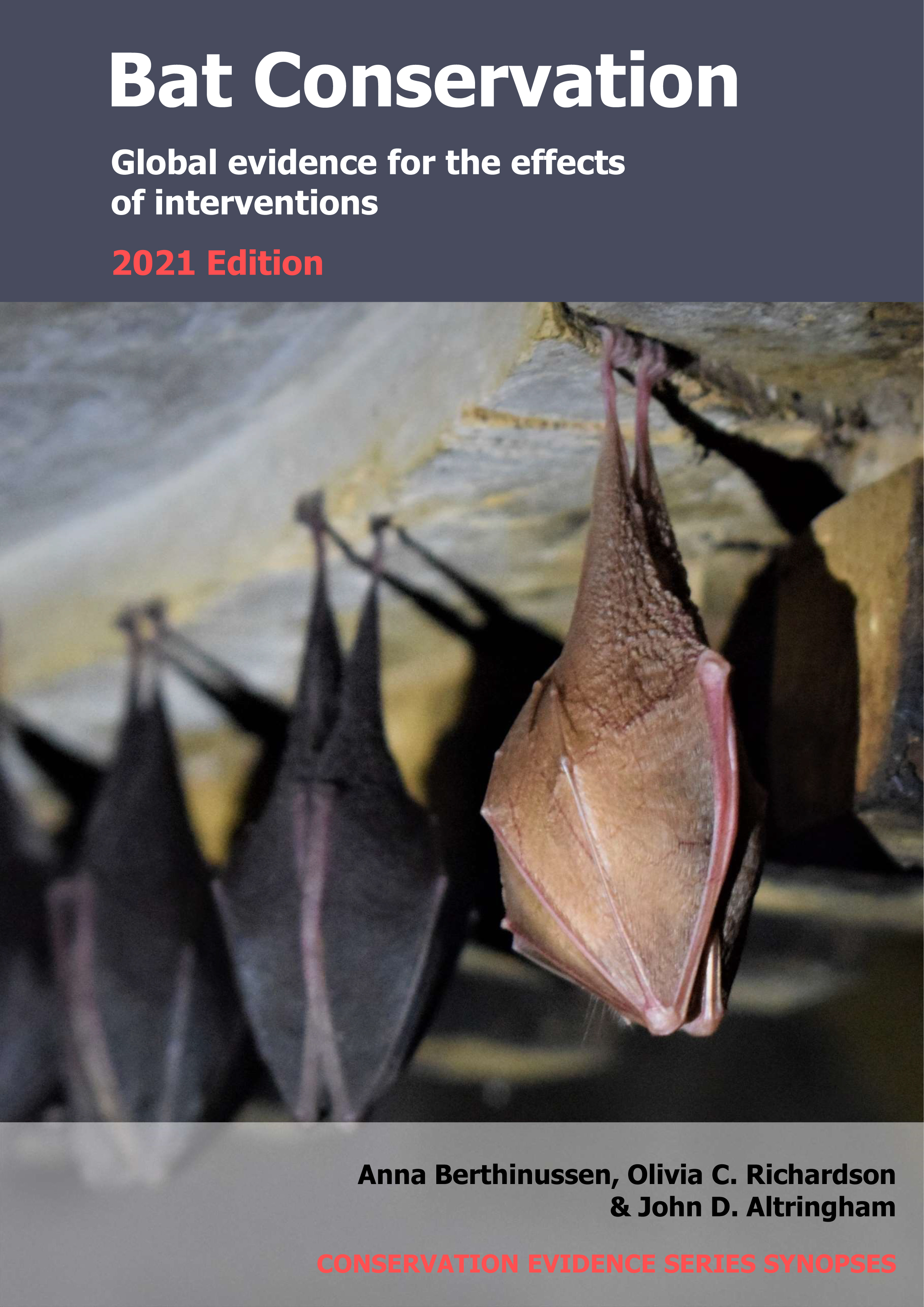Actions to conserve biodiversity
We have summarised evidence from the scientific literature about the effects of actions to conserve wildlife and ecosystems.
Review the evidence from the studies
Not sure what Actions are? Read a brief description.
Search for evidence
e.g. "frogs chytrid"
200 Actions found
Refine
Hide
200 Actions found
Download Actions
| 0 selected |
|
Order results by:
| Action | Effectiveness | Studies | Category | |
|---|---|---|---|---|
|
Introduce and enforce legislation to regulate harvesting of bat guano Action Link |
No evidence found (no assessment) | 0 |
|
|
|
Introduce certification for bat-friendly crop harvesting regimes Action Link |
No evidence found (no assessment) | 0 |
|
|
|
Introduce guidelines for sustainable cave development and use Action Link |
No evidence found (no assessment) | 0 |
|
|
|
Introduce legislation to control the use of hazardous substances Action Link |
No evidence found (no assessment) | 0 |
|
|
|
Introduce or enforce legislation to prevent ponds and streams from being contaminated by toxins Action Link |
No evidence found (no assessment) | 0 |
|
|
|
Introduce other food sources to replace bat meat Action Link |
No evidence found (no assessment) | 0 |
|
|
|
Introduce other income sources to replace bat trade Action Link |
No evidence found (no assessment) | 0 |
|
|
|
Keep domestic cats indoors at night Action Link |
No evidence found (no assessment) | 0 |
|
|
|
Leave bat roosts and roost entrances unlit Action Link |
Beneficial | 5 |
|
|
|
Legally protect bat habitats Action Link |
Likely to be beneficial | 5 |
|
|
|
Legally protect bat species Action Link |
No evidence found (no assessment) | 0 |
|
|
|
Legally protect bats during development Action Link |
Unknown effectiveness (limited evidence) | 4 |
|
|
|
Maintain bat roosts in road/railway bridges and culverts Action Link |
Likely to be beneficial | 2 |
|
|
|
Maintain forest and woodland edges for foraging bats Action Link |
No evidence found (no assessment) | 0 |
|
|
|
Maintain microclimate in closed/abandoned mines Action Link |
Unknown effectiveness (limited evidence) | 1 |
|
|
|
Manage ditches to benefit bats Action Link |
No evidence found (no assessment) | 0 |
|
|
|
Manage forest and woodland to encourage understorey growth Action Link |
Unknown effectiveness (limited evidence) | 1 |
|
|
|
Manage grazing regimes to increase invertebrate prey Action Link |
No evidence found (no assessment) | 0 |
|
|
|
Manage hedges to benefit bats Action Link |
Unknown effectiveness (limited evidence) | 2 |
|
|
|
Manage livestock water troughs as a drinking resource for bats Action Link |
Likely to be beneficial | 2 |
|
|
|
Manage microclimate of artificial bat roosts Action Link |
Unknown effectiveness (limited evidence) | 3 |
|
|
|
Manage natural water bodies in arid areas to prevent desiccation Action Link |
No evidence found (no assessment) | 0 |
|
|
|
Manage vegetation along utility and service line corridors to increase foraging habitat for bats Action Link |
No evidence found (no assessment) | 0 |
|
|
|
Minimize alterations to caves for tourism Action Link |
No evidence found (no assessment) | 0 |
|
|
|
Minimize noise levels within caves Action Link |
Unknown effectiveness (limited evidence) | 1 |
|
Download Actions
| 0 selected |
|

Bat Conservation - Published 2021
Update 2020
Watch this search
If you are familiar with RSS feeds, please click the button below to retrieve the feed URL:
RSS feed for this searchIf you are unfamiliar with RSS feeds, we would suggest reading this BBC article.
Unfortunately, due to the number of feeds we have available, we cannot provide e-mail updates. However, you could use tools such as Feed My Inbox to do this for you.
What are 'Individual studies' and 'Actions'?
Individual studies
An individual study is a summary of a specific scientific study, usually taken from a scientific journal, but also from other resources such as reports. It tells you the background context, the action(s) taken and their consequences.
If you want more detail please look at the original reference.
Actions
Each action page focuses on a particular action you could take to benefit wildlife or ecosystems.
It contains brief (150-200 word) descriptions of relevant studies (context, action(s) taken and their consequences) and one or more key messages.
Key messages show the extent and main conclusions of the available evidence. Using links within key messages, you can look at the paragraphs describing each study to get more detail. Each paragraph allows you to assess the quality of the evidence and how relevant it is to your situation.
Where we found no evidence, we have been unable to assess whether or not an intervention is effective or has any harmful impacts.





)_2023.JPG)














